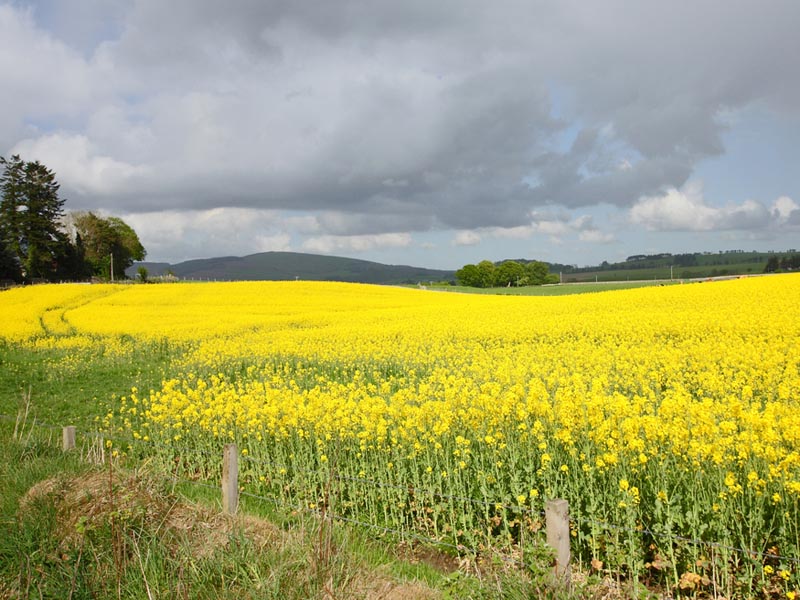Winter Oilseed Rape Update – November 2020
2 November 2020Diseases
Light leaf spot management should begin as soon as possible. The disease is spread upwards and outwards through the canopy by rain splash (so a high risk at the moment) and causes the classic scorched type symptoms that can easily be mistaken for other forms of damage. Incubating a few leaves overnight in a plastic bag will reveal the classic spores which look like salt grains around the edge of the lesion. The disease will cause puckering of the leaves and distortion of the pods if it gets that high up the canopy.
Fungicide treatments have to be applied preventatively to be successful, but in the autumn we are juggling the twin problems of getting the persistence that we need to protect over the winter period and not going too late to manage the disease. The risk of not treating in the autumn and dropping one of the two spray timings is that the disease is well established when you can travel over ground again in the early part of next year.
Trials indicate that at high risk sites where light leaf spot is usually problematic, and the variety is rated 6 (or less if you are working with varieties not on the North RL list) then two sprays, with one applied late October/mid-November is almost always the right answer. For lower risk regions and varieties rated 7 and above there is more of a split in the trial results, and about half of our trials responded, so there is less risk to dropping the autumn spray but remember you can’t row back from a diseased crop in the spring.
Options include azoles like tebuconazole at 0.5-0.75 l/ha and prothioconazole at 0.3-0.55 l/ha but also SDHI and strobilurin mixes 0.25-0.35 l/ha. These rates are roughly half to three quarters of the full label rate. Use the lower end of the range only on the lowest risk crops. Tebuconazole has some growth regulatory effect which can be useful in forward crops – use carefully if the autumn/winter forecast is hard.
Pests
Most rape crops should be beyond the need for protection from slugs now unless they are yet to achieve 3-4 leaves. Due to the risk of metaldehyde ending up in water, use of metaldehyde slug pellets should be avoided unless strictly necessary, especially bearing in mind that metaldehyde pellets should not be allowed to fall within a minimum of 10 metres of any field boundary or watercourse. Ferric phosphate slug pellets are a viable alternative.
The risk from pigeons is dependent on the crop cover, as they like a ‘gap’ (traditionally caused by slug damage) to land in and nibble away at the crop. Keep an eye on crops and take measures to keep pigeons off where slug damage or uneven emergence has led to ‘gappy’ crops.
Growers have until early November to apply an insecticide to control rape winter stem weevil. The adult weevils need to be targeted to prevent them laying eggs, as once the grubs hatch out and burrow into the stem of a plant they are beyond any insecticidal control. Adult weevils need to feed on plants for a couple of weeks before they are able to lay eggs. A cypermethrin insecticide treatment can be tank-mixed with the light leaf spot fungicide treatment (check label for compatibilities) and gives good control of rape winter stem weevil if applied before any eggs are laid. Delaying treatment into mid-November will allow egg laying and hatch to happen, and the grubs will be protected within the rape stem.
Weeds
For fields that have a grass weed problem such as brome or black-grass, propyzamide is a good herbicide option in order to try to achieve 100% grass weed control and reduce the weed seed burden for the following crops. It works well as a follow-up to an earlier graminicide spray. Soil temperature needs to be below 10°C and falling. Click here to check local conditions.
Propyzamide acts by root uptake and soil moisture is essential to achieve effective control, so it should work well this year so long as the soil is not saturated and it’s not too wet to travel on the field. Weeds need to be rooting in the top 2 cm of soil, so propyzamide is particularly suited to crops established by min-till.
When using propyzamide care must be taken to protect water. Product stewardship is designed to prevent their ingress into water courses. Do not apply if heavy rain is likely within 48 hours of spraying. Summary water protection guidelines for propyzamide:
How to stop propyzamide reaching water
All pathways matter. Follow basic water protection advice:-
- Take care when filling and cleaning the sprayer.
- Use 6m grass buffer strip, or 5m no-spray zone, beside water courses.
- Discuss cultivation and spray timing with your BASIS registered adviser.
- Manage soils and tramlines to avoid surface run-off or erosion.
- Do not apply when soils are cracked, dry or saturated.
- Do not apply propyzamide if heavy rainfall is expected within 48 hours of application.
How best to use the products
- Propyzamide works best when applied to cold moist soils, but this must be balanced with the need to protect water. Soils do not need to be completely saturated. Where practical, avoid use if drains are flowing or are likely to flow in the near future.
Dose
- Only use the maximum rate of 840gai/ha for severe black-grass situations. Lower dose rates of 700gai/ ha or 500gai/ha are recommended for less severe black-grass, other grasses and broadleaf weeds. (see product labels for details)
Additional safeguards are needed in high risk areas – click here to see the Voluntary Initiative Water Advice Sheet.
Always check the label of pre-emergence herbicides for any soil texture or other restrictions.
Sign up to the FAS newsletter
Receive updates on news, events and publications from Scotland’s Farm Advisory Service

